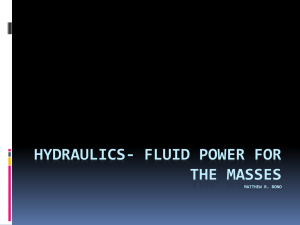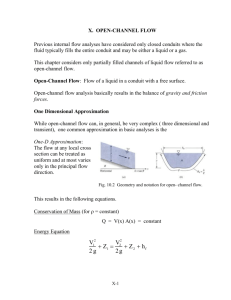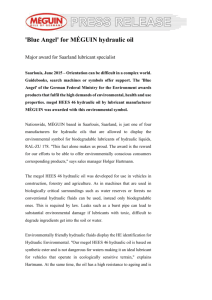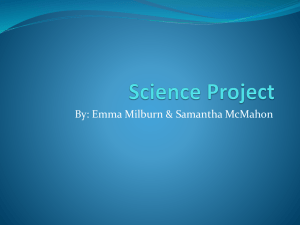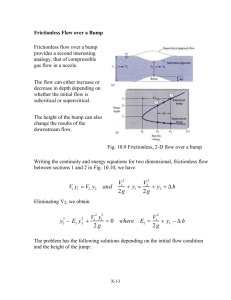Intro
advertisement
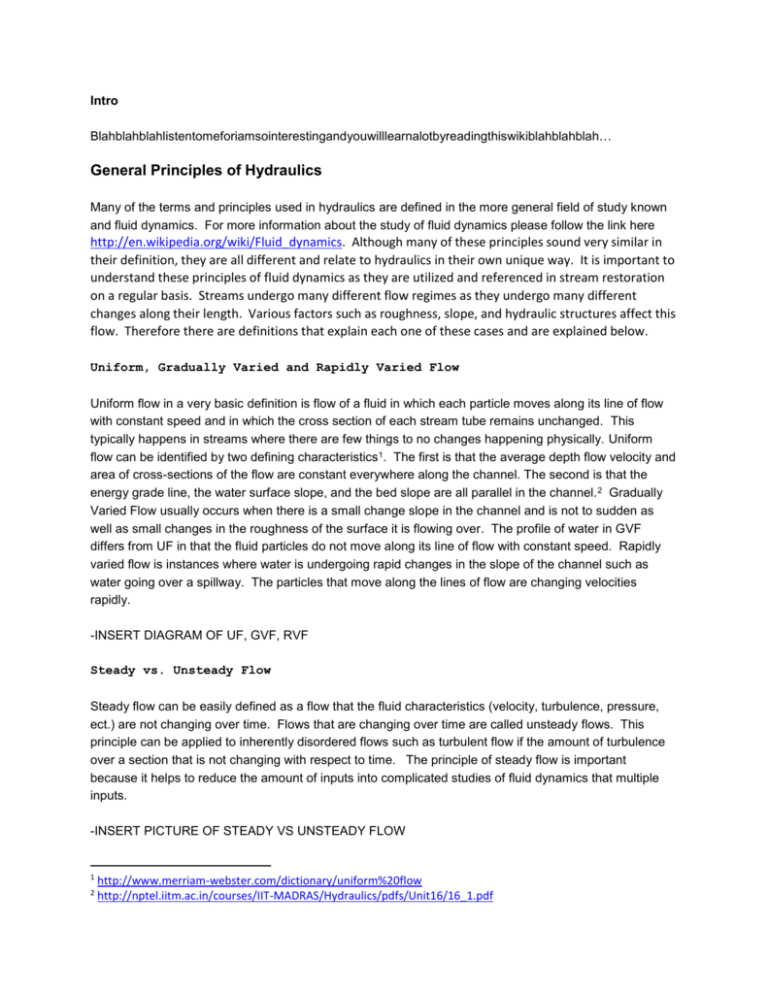
Intro Blahblahblahlistentomeforiamsointerestingandyouwilllearnalotbyreadingthiswikiblahblahblah… General Principles of Hydraulics Many of the terms and principles used in hydraulics are defined in the more general field of study known and fluid dynamics. For more information about the study of fluid dynamics please follow the link here http://en.wikipedia.org/wiki/Fluid_dynamics. Although many of these principles sound very similar in their definition, they are all different and relate to hydraulics in their own unique way. It is important to understand these principles of fluid dynamics as they are utilized and referenced in stream restoration on a regular basis. Streams undergo many different flow regimes as they undergo many different changes along their length. Various factors such as roughness, slope, and hydraulic structures affect this flow. Therefore there are definitions that explain each one of these cases and are explained below. Uniform, Gradually Varied and Rapidly Varied Flow Uniform flow in a very basic definition is flow of a fluid in which each particle moves along its line of flow with constant speed and in which the cross section of each stream tube remains unchanged. This typically happens in streams where there are few things to no changes happening physically. Uniform flow can be identified by two defining characteristics 1. The first is that the average depth flow velocity and area of cross-sections of the flow are constant everywhere along the channel. The second is that the energy grade line, the water surface slope, and the bed slope are all parallel in the channel. 2 Gradually Varied Flow usually occurs when there is a small change slope in the channel and is not to sudden as well as small changes in the roughness of the surface it is flowing over. The profile of water in GVF differs from UF in that the fluid particles do not move along its line of flow with constant speed. Rapidly varied flow is instances where water is undergoing rapid changes in the slope of the channel such as water going over a spillway. The particles that move along the lines of flow are changing velocities rapidly. -INSERT DIAGRAM OF UF, GVF, RVF Steady vs. Unsteady Flow Steady flow can be easily defined as a flow that the fluid characteristics (velocity, turbulence, pressure, ect.) are not changing over time. Flows that are changing over time are called unsteady flows. This principle can be applied to inherently disordered flows such as turbulent flow if the amount of turbulence over a section that is not changing with respect to time. The principle of steady flow is important because it helps to reduce the amount of inputs into complicated studies of fluid dynamics that multiple inputs. -INSERT PICTURE OF STEADY VS UNSTEADY FLOW 1 2 http://www.merriam-webster.com/dictionary/uniform%20flow http://nptel.iitm.ac.in/courses/IIT-MADRAS/Hydraulics/pdfs/Unit16/16_1.pdf Subcritical vs. Supercritical Flow Supercritical and Subcritical flow can be defined as different energy states within the fluid flow. Supercritical flow is at a higher energy state in which the fluid is moving faster than the wave velocity. Subcritical flow is a flow defined by a lower energy state in which the fluid is moving slower than the wave velocity. A simple example that can explain if a flow is supercritical or subcritical would be a supporting pillar for a bridge that intersects a river. In a supercritical flow, the water would be rising above the water surface and interacting with the pillar in a vigorous way, trying to “push” the pillar in the path of the velocity of the water. In a subcritical flow situation, the water would flow around the pillar not affecting the flow as much as in the supercritical case. The energy state of water is defined in many ways, one that is popular among engineers is the Froude Number http://en.wikipedia.org/wiki/Froude_number where subcritical flows are defined as numbers below 1 and super critical flows are numbers above 1. When the number 1 is achieved a energy loss is incurred as well as a hydraulic jump http://en.wikipedia.org/wiki/Hydraulic_jump for more information about these subjects please follow the links provided. -INSERT PICTURE OF HYDRAULIC JUMP WITH EGL ECT Hydraulic Calculations To study the effect of hydraulics on stream restoration calculations must be made to explain and quantify existing, historical, and future conditions of the fluid in the stream. These calculations quantify these conditions and make it possible for experts in the field to make decisions about what is needed to be done in stream restoration and other areas of research such as water resources engineering. Manning’s Equation (Normal Depth) where: V is the cross-sectional average velocity (L/T; ft/s, m/s) k is a conversion factor of 1.486 (ft/m)1/3 for U.S. customary units, if required n is the Gauckler–Manning coefficient (T/L1/3; s/m1/3) Rh is the hydraulic radius (L; ft, m) S is the slope of the water surface or the linear hydraulic head loss (L/L) (S = hf/L) In the field of open channel flow, much information about the flow can be determined through Manning’s equation such as velocity, roughness coefficient n (for more information about this parameter follow this link http://wwwrcamnl.wr.usgs.gov/sws/fieldmethods/Indirects/nvalues/index.htm), Slope and hydraulic radius. It is an empirical equation that deals with gravity fed free-surface flow. For more information about this please follow this link http://en.wikipedia.org/wiki/Manning_formula. Interactive Manning’s Equation Calculator http://www.fsl.orst.edu/geowater/FX3/help/8_Hydraulic_Reference/Manning_Equation_Flow_Generat or.htm Critical Depth In open channel flow critical depth is defined as the point at which the Froude Number equals 1. At this point the specific energy of the flow is at its minimum and the water is typically very unstable. Often, the point at which open channel flow reaches critical depth is where a hydraulic jump will occur. For rectangular channels, the critical depth, dc ft (m), is given by dc =[Q2/b2g]1/3 where dc =critical depth, ft (m) Q= quantity of flow or discharge, ft3/s (m3/s) B= width of channel3, ft (m) Continuity Equation The continuity equation explains the phenomena of transporting a conserved mass, energy, momentum, ect. For open channel hydraulics it is used to explain the basic principle of the conservation of mass, energy and momentum. 𝑄 =𝑉∗𝐴 Where Q = Flow (L3/T) V = Velocity (L/T) A = Area (L2) For more in depth information about this please follow this link http://en.wikipedia.org/wiki/Continuity_equation 3 http://www.engineeringcivil.com/critical-depth-of-open-channel-flow.html Energy Equation The energy equation used in hydraulics is based off of the first law of thermo dynamics and then is related to the Bernoulli Equation. The first law of thermo dynamics where “time rate of increase of the total stored energy of the system = net time rate of energy addition by heat transfer into the system + net time rate of energy addition by work transfer into the system.” (Munson p. 223) 𝑝1 𝑉12 𝑝2 𝑉22 + + 𝑧1 + ℎ𝑙 = + + 𝑧2 + ℎ𝑝 𝛾 2𝑔 𝛾 2𝑔 Where p/γ = Pressure Head V2/2g = Velocity Head z = Elevation Head hl = Head Loss hp = Pump Head Momentum Equation The momentum equation relates the principles of Bernoulli’s Equation but incorporates the conservation of momentum within it. Basically put it is the Bernoulli’s Equation for fluid flow that takes into account head losses. 𝑝1 𝑉12 𝑝2 𝑉22 + + 𝑧1 + ℎ𝑙 = + + 𝑧2 𝛾 2𝑔 𝛾 2𝑔 Where p/γ = Pressure Head V2/2g = Velocity Head z = Elevation Head hl = Head Loss Hydraulic Models 1D models and assumptions (HEC-RAS) To meet the needs of modern engineering one dimensional hydraulic models such as HEC-RAS were developed to speed up the process of analyzing hydraulic systems and the way that water moves through rivers and channels. 1-D modeling does not take into account the direct hydraulic effect of changes in dimensions to cross-sections, bends and the two or three dimensional aspects of the flow. HEC-RAS was developed to utilize the concepts such as the momentum and energy equation and its variables as well as the Saint-Vernant equation to assess flows in channels. It is able to output information about where hydraulic jumps may exist, if the flow is sub or super critical, flow velocity, discharge, and stage height. For more information about HEC-RAS follow this link (http://en.wikipedia.org/wiki/HEC-RAS). 2D models and assumptions (SRH-2D, RMA, CCHE2D) Two dimensional models are similar to one dimensional models in many ways but one of the main differences between the two is the ability to not assume that flow outside of the main channel is not assumed to be parallel to the main channel. It is then more accurately able to predict flow in situations where flow goes above the main channel into the floodplain. Models that have been developed to deal with 2-D flow are SRH-2D - http://www.usbr.gov/pmts/sediment/model/srh2d/, RMA http://www.xmswiki.com/xms/SMS:RMA2, and CCHE2D - http://www.ncche.olemiss.edu/cche2d. 3D models (Fluent, OpenFOAM, etc) Three dimensional models are very new in the field of hydraulics and their its use has been limited cases but has been starting to gain some ground in its application. Finite element programs such as Fluent ( www.ansys.com/Industries/Academic/ANSYS+FLUENT+Academic+Product+Tutorials) have started to analize hydraulic problems. Another program that is on the market that has some use as well is OpenFOAM – (http://www.openfoam.com/). o o o o Hydraulics and Stream Restoration o Habitat heterogeneity -- > Discuss David Crowder and P. Diplas Paper Using 2-D modeling to determine optimal placing of hydraulic featuers such as rocks for stream restoration efforts. Advantages/Disadvantages over 1-D modeling. Engineering stream habitat Case study -- MRG floodplain channels ??? Tabacchi paper Main Channel – regular and low flows Debris types and effects Riparian Zone and secondary channels Flux between river and riparian zones Hydraulic connectivity Floodplains acting as dissipative structures Case study Conclusions Works Cited Munson, Young, Okiishi, Huebsch, 2009. Fundamentals of Fluid Mechanics (6 th Edition). United States of America: Don Fowley




